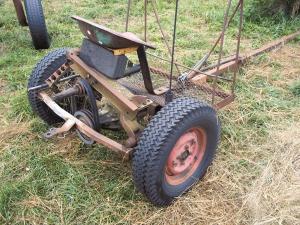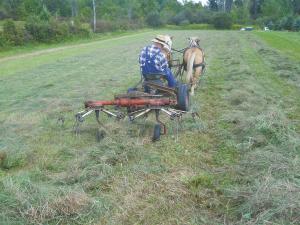2018 - Volume #42, Issue #1, Page #36
[ Sample Stories From This Issue | List of All Stories In This Issue | Print this story
| Read this issue]
Ground-Drive PTO Carts
 |
 |
“I mostly use a team of Haflingers now, but the miniatures handled the tedder without a problem,” recalls Gies.
Gies and his wife operate their small farm completely with horses and on a tight budget. He neither needs, nor can he justify, large equipment whether tractor-drawn or horse-drawn. As a result, he has fabricated much of his own equipment, including 2 tedders, a hay loader, a buck rake and more.
“All my metal work is with a hacksaw and a 110-volt wire feed welder. It is enough for my light horse-drawn equipment,” says Gies, a frequent contributor to Small Farmer’s Journal (smallfarmjournal.com).
An article there outlined his use of pto carts with in-depth guidelines for sizing the cart design to the equipment being powered, such as his tedders.
Gies has two tedders, both cut down from large 4-star tedders with wings. Each features 2 rotors. The first tedder was modified from a salvaged wing to a 7-ft. width. The second was a center section with bent wheel stems that had to be straightened. It is only 5 ft. wide.
Gies designed each of his carts specifically for a tedder. The cart for the 7-ft. tedder consists of an axle from a small pickup truck that Gies found in a junk pile. The operator’s platform consists of expanded metal attached to a frame made from scrap angle iron and other salvaged steel. The tongues on both carts are made from schedule 40 pipe.
After adding 13-in. car tires to the axle, Gies rolled it across the ground to get the revolutions per turn of the wheel, which he converted to the speed he wanted in order to size the pulleys needed.
The lower pulley is a clamp-on pulley attached to the differential driveshaft. The upper clamp-on pulley is on a jackshaft from a scrapped baler. It is attached to a steel arm hinged to the right side of the axle. A screw jack mounted between the end of the arm and the left side of the axle tightens the belt by raising the upper pulley.
The rotors initially spun outward. To reverse them to spin inward, Gies initially ran the drive belts in a figure 8. This caused wear on the belts, so Gies looked for another solution. He split the gearbox, pulled one side off, and turned the shaft over to feed the other side of the input pinion. This reversed direction on the rotors, eliminating the need for the figure 8 belts.
When Gies started using miniature horses he needed a smaller, lighter tedder, resulting in the 5-ft. unit. It is based on a 6-speed transaxle from a scrapped lawn mower, traction wheels picked up cheap at auction and a previously salvaged gearbox. Gies welded a spline adapter from a Farmall Cub on the end of the gearbox shaft to get the splines to match the tedder pto shaft. A homemade shifting lever lets him control speeds.
“With the 6 speeds, I can spin fast or slow,” says Gies. “The shaft coming out of the transaxle and through the gearbox runs backward, which is fine. The center section originally ran backward, but with the backward shaft, it runs the right way.”
The lighter tedder works fine with a team of miniatures, as it does with Gies’ current Haflingers. It is light enough that he can convert the cart quickly to working with a single Haflinger.
“The only problem is the narrow cart rides rough,” says Gies. “I find it easier to walk alongside.”
Contact: FARM SHOW Followup, Ken Gies, 660 Fordsbush Rd., Fort Plain, N.Y. 13339 (ph 518 568-5322; giespasture@frontiernet.net).

Click here to download page story appeared in.

Click here to read entire issue
To read the rest of this story, download this issue below or click here to register with your account number.




